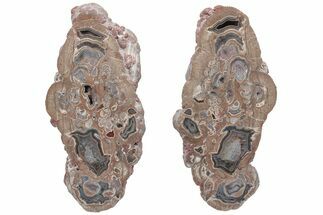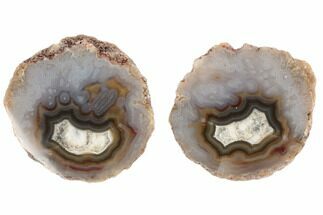This Specimen has been sold.
2.6" Polished Baker Ranch Thunderegg (Half) - New Mexico
This is a gorgeous "Baker Ranch Thunderegg" half collected from New Mexico. It features a spectacular array of banding and colors in rich reds and pinks. This specimen comes with an acrylic display stand.
Baker Egg agate (also known as Baker Ranch agate) is a type of agate that formed as thundereggs (lithophysae) from a primarily rhyolite-perlite host rock. They are collected from an area southwest of Deming, New Mexico that was formerly known as Baker Ranch. These thundereggs are unique in that they exhibit vibrant coloration typically only found in agate nodules (amygdaloids).
Thundereggs are rarely found in any other color than white, blue or grey-blue, yet Baker Egg Mine produces mixtures of red, yellow, black, white and, in rare cases, green agate. This is due to the unique geologic history of the area, where rhyolitic lava deposits were disrupted by a mixture of geologic forces and the introduction of basaltic and andesitic lava flows over millions of years. These additional lava flows likely provided the minerals necessary for the variety of coloration found in Baker Egg agates (thundereggs).
Thundereggs are rarely found in any other color than white, blue or grey-blue, yet Baker Egg Mine produces mixtures of red, yellow, black, white and, in rare cases, green agate. This is due to the unique geologic history of the area, where rhyolitic lava deposits were disrupted by a mixture of geologic forces and the introduction of basaltic and andesitic lava flows over millions of years. These additional lava flows likely provided the minerals necessary for the variety of coloration found in Baker Egg agates (thundereggs).
About Agate
Agate is a variety of microcrystalline quartz (chalcedony) that displays translucence and, in some cases, banding. Agate primarily forms when silica-rich fluids fill pockets within rocks and/or fossils, depositing the silica along the walls of the rock. This process can result in banding patterns, as the compositions and impurities of these depositing fluids change over time. These banding patterns can either form as flat layers, creating linear patterns known as waterline agate, or as rounded layers, forming more common ring-like patterns. These patterns depend on the surfaces available for deposition.
Agate is a variety of microcrystalline quartz (chalcedony) that displays translucence and, in some cases, banding. Agate primarily forms when silica-rich fluids fill pockets within rocks and/or fossils, depositing the silica along the walls of the rock. This process can result in banding patterns, as the compositions and impurities of these depositing fluids change over time. These banding patterns can either form as flat layers, creating linear patterns known as waterline agate, or as rounded layers, forming more common ring-like patterns. These patterns depend on the surfaces available for deposition.
SPECIES
Chalcedony var. Agate
LOCATION
Baker Egg Mine, Southwest of Deming, New Mexico
SIZE
2.6 x 2.5", up to 1.55" thick
CATEGORY
SUB CATEGORY
ITEM
#245256
 Reviews
Reviews












